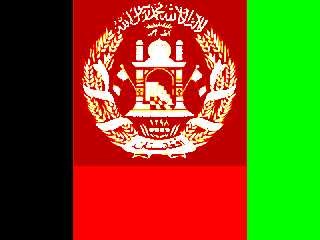|
 |
High!
Meanwhile, I finally found out how to display object patterns produced
from bitmaps vectorized with Inkscape correctly... but then, I found
that either the lowest layer (a simple three-column flag gradient
pattern) is darkened completely or significantly brightened (see
attached image).
Here is the current version of my AfghanFlag() macro:
// beginning of code
#macro Flags_AfghanFlag()
Flags_ThreeColumnFlag(0, <0.74509805, 0, 0>, <0, 0.6, 0>) // Layered
texture, coat of arms object-patterned texture yet to be added!
texture
{
pigment
{
object
{
path2428
translate -y*0.5
rotate -x*90
scale <1/410*(Flags_Height/Flags_Width), 1/410, 0>
translate <0.3335, 0.32, 0>
color rgbft <1, 1, 1, 1, 1>
color rgbft <0.98431373, 0.96862745, 0.96078432, 0,
0>*ambientFactor
}
}
finish { ambient Flags_Brightness/ambientFactor }
normal { Flags_Normal }
}
texture
{
pigment
{
object
{
path2426
translate -y*0.5
rotate -x*90
scale <1/410*(Flags_Height/Flags_Width), 1/410, 0>
translate <0.3335, 0.32, 0>
color rgbft <1, 1, 1, 1, 1>
color rgbft <0.90588236, 0.79607844, 0.66274512, 0,
0>*ambientFactor
}
}
finish { ambient Flags_Brightness/ambientFactor }
normal { Flags_Normal }
}
texture
{
pigment
{
object
{
path2424
translate -y*0.5
rotate -x*90
scale <1/410*(Flags_Height/Flags_Width), 1/410, 0>
translate <0.3335, 0.32, 0>
color rgbft <1, 1, 1, 1, 1>
color rgbft <0.88627452, 0.67058825, 0.58431375, 0,
0>*ambientFactor
}
}
finish { ambient Flags_Brightness/ambientFactor }
normal { Flags_Normal }
}
texture
{
pigment
{
object
{
path2422
translate -y*0.5
rotate -x*90
scale <1/410*(Flags_Height/Flags_Width), 1/410, 0>
translate <0.3335, 0.32, 0>
color rgbft <1, 1, 1, 1, 1>
color rgbft <0.82745099, 0.59215689, 0.34509805, 0,
0>*ambientFactor
}
}
finish { ambient Flags_Brightness/ambientFactor }
normal { Flags_Normal }
}
texture
{
pigment
{
object
{
path2420
translate -y*0.5
rotate -x*90
scale <1/410*(Flags_Height/Flags_Width), 1/410, 0>
translate <0.3335, 0.32, 0>
color rgbft <1, 1, 1, 1, 1>
color rgbft <0.83529413, 0.38039216, 0.36862746, 0,
0>*ambientFactor
}
}
finish { ambient Flags_Brightness/ambientFactor }
normal { Flags_Normal }
}
texture
{
pigment
{
object
{
path2418
translate -y*0.5
rotate -x*90
scale <1/410*(Flags_Height/Flags_Width), 1/410, 0>
translate <0.3335, 0.32, 0>
color rgbft <1, 1, 1, 1, 1>
color rgbft <0.77647060, 0.39607844, 0.14117648, 0,
0>*ambientFactor
}
}
finish { ambient Flags_Brightness/ambientFactor }
normal { Flags_Normal }
}
texture
{
pigment
{
object
{
path2416
translate -y*0.5
rotate -x*90
scale <1/410*(Flags_Height/Flags_Width), 1/410, 0>
translate <0.3335, 0.32, 0>
color rgbft <1, 1, 1, 1, 1>
color rgbft <0.76862746, 0.14117648, 0.09803922, 0,
0>*ambientFactor
}
}
finish { ambient Flags_Brightness/ambientFactor }
normal { Flags_Normal }
}
texture
{
pigment
{
object
{
path2414
translate -y*0.5
rotate -x*90
scale <1/410*(Flags_Height/Flags_Width), 1/410, 0>
translate <0.3335, 0.32, 0>
color rgbft <1, 1, 1, 1, 1>
color rgbft <0.74509805, 0.00000000, 0.00000000, 0,
0>*ambientFactor
}
}
finish { ambient Flags_Brightness/ambientFactor }
normal { Flags_Normal }
}
#end
// end of code
Inkscape generated 8 vectorized layers from the original coat-of-arms
bitmap; originally, I just used finish { Flags_Finish } as defined
further up in flags.inc. As in flags.pov, the flag object is called with
the newly introduced "lights" parameter set to 0, the ambient value in
Flags_Finish is 1.
The original color values for the three-column pattern are (in 8-bit
notation):
<0, 0, 0>
<191, 0, 0>
<153, 0, 0>
But when I add the first layer with object pattern, the colors beneath
darken significantly:
<0, 0, 0>
<125, 0, 0>
<51, 0, 0>
- although the color for all parts outside the bezier spline is set to
rgbft 1 and also the finish of the object pattern texture layer is
ambient 1! From the second layer on, the red and green beneath is even
reduced to a total black! How is this possible?
On the other hand, when I instead divide the ambient value by a value
higher than 1.7 (and, in turn, multiply color triple of the inner parts
of the object pattern with the same value), the colors of the flag are
brightened to:
<0, 0, 0>,
<255, 0, 0>,
<0, 255, 0>
Why?
See you in Khyberspace!
Yadgar
Post a reply to this message
Attachments:
Download 'afghanflag.png' (66 KB)
Preview of image 'afghanflag.png'

|
 |




![]()